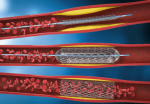Aspiration thrombectomy (AT) in patients with high thrombotic burden could pathophysiologically reduce thrombus burden, decrease distal embolization, reduce no-reflow phenomenon, and improve microvascular perfusion. However, its usefulness has not been shown in the large, randomized trials (TASTE and TOTAL) that compared routine use of AT in primary angioplasty in patients with ST-segment elevation acute coronary...
Balloon expandable vs Self-Expanding Valves: The Best Option for ViV-TAVR in Small Annuli
TAVR has consolidated as an increasingly valid alternative to treat failed surgical aortic valve bioprostheses. One of the major challenges it presents is patients with small annuli treated with a surgical bioprosthesis. There is little data available about this scenario. A few observational studies have shown what appears to be a hemodynamic advantage of...
The Best of the SOLACI-SOCIME 2022 Main Arena: Day 3
Lecture by Dr. Hector García García – LM-PCI: IVUS and FFR/IFR? Dr. Hector García delivered an excellent presentation on whether we should use intravascular ultrasound (IVUS) or fractional flow reserve (FFR)/instantaneous wave-free ratio (iFR) in the left main coronary artery (LMCA) to consider severe obstruction, since there is significant interobserver variability with angiography. Although the...
The Best of SOLACI-SOCIME 2022 Main Arena – Chronic Total Occlusions (CTO)
How to Choose the Best Approach in Chronic Total Occlusions, by Dr. Jean-Michel Paradis CTO are present in around 16 to 20% of patients with coronary artery disease who get a coronary angiography. CTO Percutaneous intervention has been on the rise, mainly due to equipment and technique advancement. During his presentation, Dr. Paradis mentioned the...
The Best of the SOLACI-SOCIME 2022 Main Arena: New Paradigms in Angioplasty
“New Paradigms in Angioplasty,” by Dr. Gregg Stone While most studies on angioplasty in stable coronary artery disease have shown an improvement in angina frequency and exercise capacity, there is no significant reduction in death and acute myocardial infarction (AMI). Currently, one of the main factors is the definition of vulnerable plaque, because it is...
The Best of the SOLACI-SOCIME 2022 Main Arena: Complex PCI Guided by Intravascular Imaging
In the first session of SOLACI-SOCIME 2022 on “Complex angioplasty guided by intravascular imaging”, Dr. Alejandro Diaz (MEX) reviewed the evidence on intravascular ultrasound (IVUS) in complex angioplasties. A meta-analysis indicated its use is associated with a significant decrease in the risk of death, acute myocardial infarction (AMI), and new target lesion revascularization (TLR) in...
Changes in Coronary Collateral Function Post CTO Intervention
In the last few years, we have seen significant growth of chronic total occlusion (CTO) percutaneous intervention, which has also been considered for patients with viable territory that remain symptomatic. Experienced centers present successful CTO intervention rates close to 90%, especially with a hybrid approach. However, it is still a complex procedure, and target vessel...
Three-Year Outcomes after CTA with 2-Stent Technique Vs. Provisional Stenting for Complex Bifurcation Lesions
The prevalence of coronary lesions with bifurcation involvement is about 20% in patients undergoing coronary angiography (CTA). While provisional stenting is overall the most accepted technique, the 2018 myocardial revascularization guidelines recommend the 2-stent technique for complex bifurcation lesions, defined as side branch with lesion >5mm, distal reference diameter of the side branch ≥2.75, or...
Same Day Discharge in NSTE-ACS: Is It Possible?
At present, percutaneous coronary intervention (PCI) is the most common coronary revascularization strategy. One of its benefits is that patients can be safely discharged when procedures are programed, which helps decompress hospital capacity. However, this strategy has not been validated for acute coronary syndromes; the evidence gathered for non-ST elevation ACS is far from robust,...
Intermittent Claudication: Invasive Treatment Superior to Pharmacological Treatment?
Peripheral vascular disease is strongly associated to cardiovascular events and a negative impact on health status and quality of life. However, researchers are yet to determine the benefit of early intervention in patients presenting intermittent claudication, and whether it improves quality of life. At present, there is little information in this regard (CLEVER trial), and...









